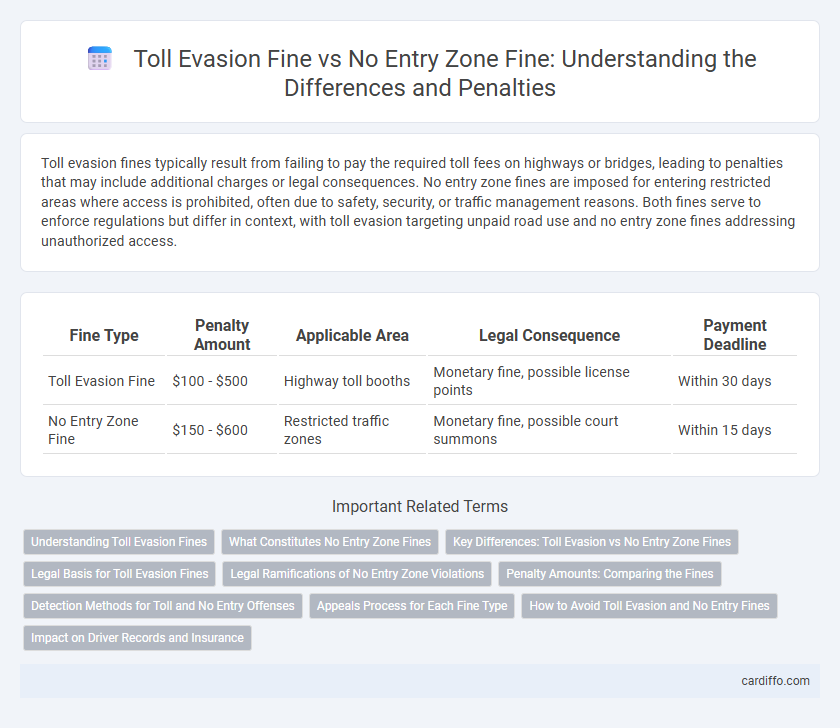Toll evasion fines typically result from failing to pay the required toll fees on highways or bridges, leading to penalties that may include additional charges or legal consequences. No entry zone fines are imposed for entering restricted areas where access is prohibited, often due to safety, security, or traffic management reasons. Both fines serve to enforce regulations but differ in context, with toll evasion targeting unpaid road use and no entry zone fines addressing unauthorized access.
Table of Comparison
| Fine Type | Penalty Amount | Applicable Area | Legal Consequence | Payment Deadline |
|---|---|---|---|---|
| Toll Evasion Fine | $100 - $500 | Highway toll booths | Monetary fine, possible license points | Within 30 days |
| No Entry Zone Fine | $150 - $600 | Restricted traffic zones | Monetary fine, possible court summons | Within 15 days |
Understanding Toll Evasion Fines
Toll evasion fines are monetary penalties imposed on drivers who use toll roads without paying the required fees, aiming to discourage non-compliance and ensure road maintenance funding. These fines are typically higher than no entry zone fines because toll evasion directly causes revenue loss for transportation authorities. Understanding toll evasion fines involves recognizing their role in promoting fair road usage and the legal consequences of avoiding toll payments.
What Constitutes No Entry Zone Fines
No Entry Zone fines are imposed when vehicles enter restricted areas designated by clear signage and road markings, typically meant to prevent unauthorized access to sensitive or high-traffic zones. These fines differ from Toll Evasion fines, which occur when drivers fail to pay mandatory toll charges at toll booths or electronic toll collection points. Enforcement of No Entry Zone violations often involves automated camera systems that capture the vehicle's license plate to ensure compliance and issue penalties.
Key Differences: Toll Evasion vs No Entry Zone Fines
Toll evasion fines primarily target drivers who avoid paying toll fees on highways and bridges, resulting in penalties based on the toll amount plus additional administrative fees. No entry zone fines address unauthorized entry into restricted areas, with penalties often fixed regardless of distance traveled or duration of violation. Enforcement methods differ, as toll evasion is detected through electronic toll collection systems, while no entry zone violations rely on traffic cameras or police monitoring for illegal access.
Legal Basis for Toll Evasion Fines
Toll evasion fines are primarily enforced under specific transportation and vehicle regulations that mandate payment for road usage, ensuring the maintenance and development of infrastructure funded by toll revenue. Legal frameworks usually specify penalties for failing to pay tolls, ranging from monetary fines to administrative sanctions, reinforcing compliance through automated toll collection and enforcement systems. Compared to No Entry Zone fines, which are often governed by traffic control laws aiming to restrict unauthorized access to certain areas, toll evasion fines are distinct in their focus on revenue protection and road user accountability under transportation law statutes.
Legal Ramifications of No Entry Zone Violations
Violations in No Entry Zones carry strict legal ramifications, including penalties that often surpass toll evasion fines due to the potential risk to public safety. Authorities impose substantial fines and may initiate legal proceedings, emphasizing the seriousness of ignoring access restrictions. Understanding local traffic regulations and respecting No Entry signage is critical to avoiding these legal consequences and ensuring road safety compliance.
Penalty Amounts: Comparing the Fines
Toll evasion fines typically range from $50 to $200 depending on the state or country, aiming to discourage drivers from bypassing toll payments. No entry zone fines are often higher, starting around $100 and escalating to $500 or more due to the safety risks involved. These penalty amounts reflect the severity of the violations, with no entry zone fines carrying a greater financial deterrent compared to toll evasion fines.
Detection Methods for Toll and No Entry Offenses
Toll evasion fines are primarily enforced through automated license plate recognition (ALPR) cameras that capture vehicles passing without payment, combined with electronic toll collection systems recording unpaid tolls. No entry zone fines rely on traffic surveillance cameras and sensors positioned at restricted access points to detect unauthorized vehicle entry, often supported by real-time monitoring from traffic control centers. Both enforcement methods utilize advanced imaging technology and database cross-referencing to accurately identify offenders and issue fines.
Appeals Process for Each Fine Type
The appeals process for toll evasion fines typically involves submitting evidence such as payment proof or vehicle ownership details within a specified timeframe, often 30 days, to a designated transport authority or fine enforcement agency. In contrast, contesting a no entry zone fine usually requires a formal appeal through traffic tribunals or local councils, where photographic evidence and valid exemptions are reviewed. Understanding each process's deadlines and required documentation significantly increases the chances of a successful appeal.
How to Avoid Toll Evasion and No Entry Fines
To avoid toll evasion and no entry zone fines, always ensure your vehicle has a valid electronic toll tag or pay tolls promptly through official channels. Familiarize yourself with local traffic signs and use GPS navigation apps with real-time updates to recognize restricted entry areas beforehand. Regularly check your vehicle's registration details and payment receipts to prevent inadvertent violations and penalties.
Impact on Driver Records and Insurance
Toll evasion fines and no entry zone fines both negatively impact driver records but differ in severity and insurance consequences. Toll evasion fines often result in points added to the driver's license and can increase insurance premiums due to perceived higher risk. No entry zone fines may lead to more severe penalties, including higher insurance surcharges and potential license suspension, significantly affecting a driver's insurance rating and driving privileges.
Toll Evasion Fine vs No Entry Zone Fine Infographic

 cardiffo.com
cardiffo.com